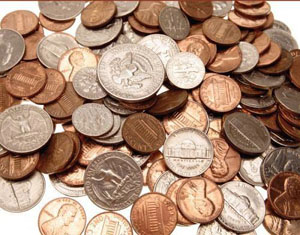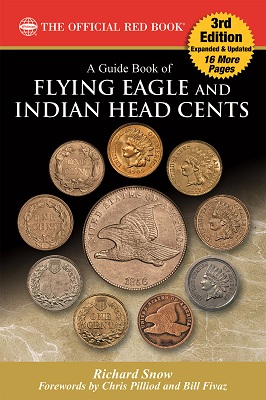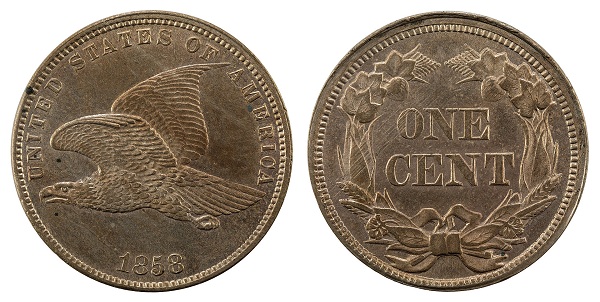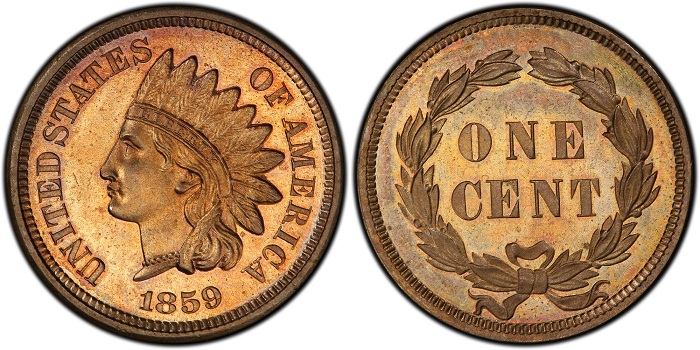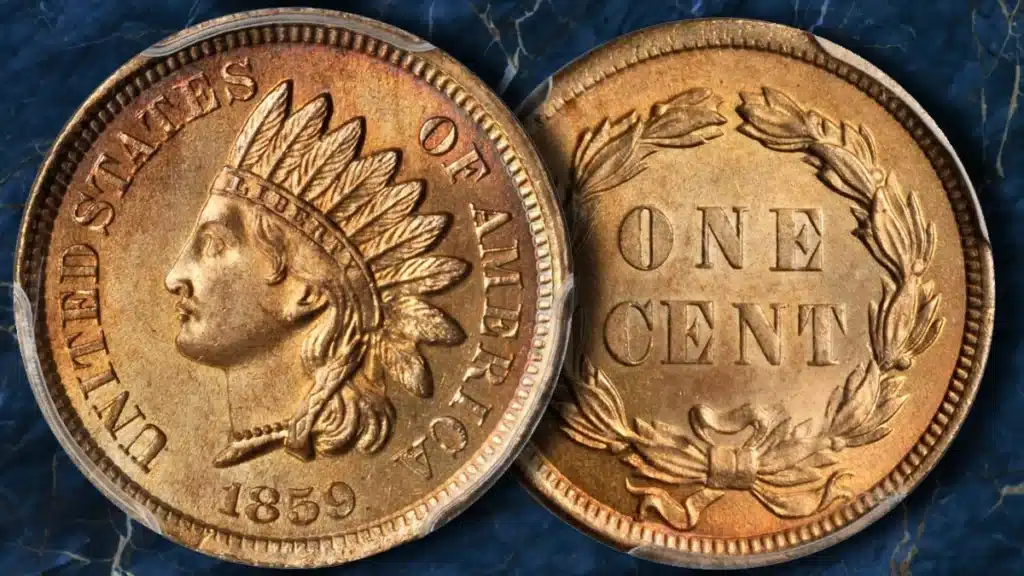
The Indian Head Cent Replaces the Flying Eagle
The story of the 1859 Indian Head cent should probably begin in 1856, when the United States Mint first struck small cents following a decade of concern about the rising cost of copper. At the time, the United States was producing two copper coins: a 10.89 gram “large cent” that measured 27.5 mm in diameter and a 5.44 gram half cent that measured 23 mm. The basis for these sizes and weights was the cost of the metal minus some small fee for the government to produce the coins.
As this relationship was no longer economincally sustainable, the United States Congress opted to eliminate the half cent and shrink the size of the cent down to the 19 mm standard we’re all familiar with today. In 1856, James Barton Longacre, the Mint’s fourth Chief Engraver, adapted an eagle motif from his predecessor, Christian Gobrecht, for the new one-cent coin. That coin design became known as the Flying Eagle cent.
These first small cents were struck of an alloy composed of 88 percent copper and 12 percent nickel, as required by law. This hard metal alloy proved difficult to strike and caused dies to fail prematurely. The Mint found fault with the Flying Eagle design and quickly sought an alternative.
Tests conducted in 1858 found that Longacre’s new design featuring Lady Liberty wearing an Indian headdress would lead to longer die life.
Mint Director James Ross Snowden liked the design, and wrote a letter on November 4, 1858 to Treasury Secretary Howell Cobb, suggesting that a change be made in the design of the Flying Eagle cent. He pointed out that its relief was too high, and that the design did not seem too acceptable to the public. Snowden submitted models for a new design, and Secretary Cobb gave his approval to what later became the Indian Head cent.
The Indian Head cent went into production in January 1859 and would be struck for 50 years, when the Mint marked the centennial of President Abraham Lincoln’s birth with the release of the Lincoln cent in 1909.
Early Changes to the Indian Head Cent
While the Indian Head cent was struck from 1859 to 1909, major changes to the design were made to the cent in 1860 and 1864.
The 1859 Indian Head cent features Longacre’s Liberty wearing an Indian headdress motif on the obverse and a simple laurel wreath on the reverse. This coin, like the “failed” Flying Eagle cent, was struck in a hard copper-nickel alloy.
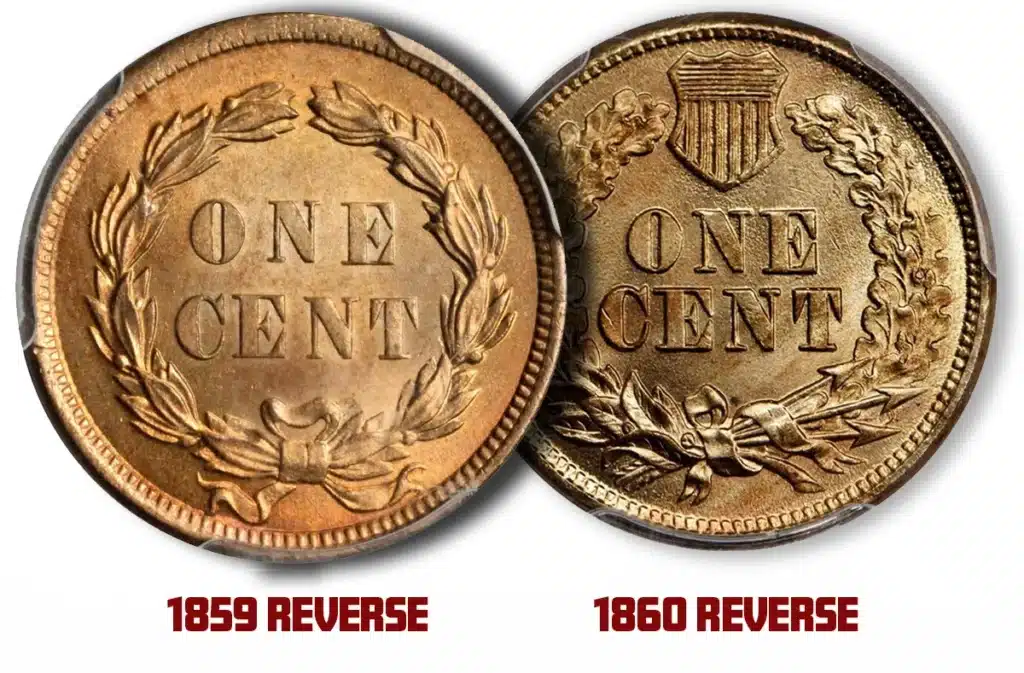
For Indian Head cents struck from 1860 onward, the reverse design featured an oak wreath surmounted by a federal shield. This new wreath left less space for the denomination, which meant that the letters had to be set closer together. In our opinion, the reverse of 1860 was a marked improvement over Longacre’s original design.
The use of copper-nickel continued until partway through 1864, at which time the composition of the cent was changed to bronze. Bronze would serve the nation well for much of the next century, when a tiny amount of tin was removed from the alloy in 1959.
The Indian Head Cent’s Impact on American Coin Design
James Barton Longacre scored the job of Chief Engraver through political influence and at first, he had very little practical experience designing coins. He was, however, a talented man who learned the trade through trial and error. In time, Longacre would go on to have a tremendous influence on America’s coins that spanned beyond his tenure at the Mint.
Many popular coin types of the latter half of the 19th century were Longacre designs, including the two-cent piece, the three-cent silver and three-cent nickel, the Shield nickel, the gold dollar, the three-dollar gold coin, and the Liberty Head double eagle.
But it is Longacre’s Indian Head cent design which we feel was his most impactful. In imbuing American idealism with the unique iconography of its indigenous peoples (albeit in pastiche), he set forward an artistic movement for United States coin and medal design. In time, Native American motifs would appear on the nickel five-cent coin; the quarter eagle, half eagle, and eagle gold coins; a number of classic commemorative coin issues; and even the Sacagawea dollar.
For Longacre, the cent was a continuation of his marriage of Indian-style headgear with Liberty that began on the much less successful gold dollar and three dollar gold designs of 1854.
What Is the 1859 Indian Head Cent Worth?
As with the case for all coins, the value of the 1859 Indian Head cent depends on its current state of preservation and eye appeal. A total of 36,400,000 Indian Head cents dated 1859 were struck for circulation and they were meant to be spent. The majority of the issue entered into circulation, practically choking the streams of commerce.
With the outbreak of the American Civil War in 1861, coins of all types were quickly removed from circulation and hoarded–mainly by institutions and speculators. At the termination of the “hot” phase of the war in 1865, the Mint had replaced the metal composition of the Indian Head cent with a lighter bronze alloy. This change made the copper-nickel cents noticeably heavier and paler than their new tenor counterparts.
When such changes happen in coinage, the old type tends to be removed from circulation in favor of the new. Whether through redemption or the ravages of time, most of the 36 million 1859 Indian Head cents were lost or destroyed.
A sufficient number of coins survive, however, and this inventory provides coin collectors of all budgets the opportunity to own an 1859 Indian Head cent for as little as $15 to $20 for a specimen in Good condition up to a few hundred dollars for a slightly worn example in About Uncirculated.
Above the grade of AU, it is advisable that collectors buy only certified coins that have been graded by CAC, NGC, or PCGS – the three main third-party grading services operating in the United States.
1859 Indian Head Cents in Mint State – Top Population and Value
At the time of publication in late November 2023, NGC, PCGS, and CAC combined have graded over 7,200 1859 Indian Head cents. Due to the costs of certification, the majority of the coins submitted from this date will fall within the upper circulated grades through the Mint State grade of MS64.
NGC reports one coin at its top grade of MS67. PCGS reports 11 grading events at its top grade of MS66+. CAC has not encapsulated any coin above MS65, but has applied its approval sticker to 17 coins at the MS66 level (please note: CAC’s sticker service does not account for the plus grades assigned to a coin by NGC or PCGS).
In Mint State grades, the 1859 Indian Head cent is more affordable today than it has been at any point in the past 10 years. In Choice Mint State MS63, examples have realized prices ranging from $550 to $800 at auction in 2023. Gem Mint State coins at MS65 have sold for between $2,200 and $2,500. At the upper end, a non-CAC-approved example graded MS66+ sold at GreatCollections for $17,718.75. A decade ago, this coin would have likely sold for $25,000 or more.
As with anything related to rare coins, timing is important. When two or more knowledgable bidders vie for the same piece, the price realized will often be far more than the published “value” of the coin. Eye appeal, provenance, and advanced features like die marriage, die state, and die variety can also greatly impact a coin’s value.
1859 Indian Head Cent in Proof
In addition to the 36 million 1859 Indian Head cents struck for circulation, the Philadelphia Mint also produced approximately 800 Proof examples. Proof coins have mirrored surfaces and were struck with two blows from the dies. Coin expert Rick Snow has written that he believes half of this mintage was released into circulation after the coins went unsold. Determining whether a circulated or impaired coin is a Proof or a business strike can be tricky and is best left to the experts.
Proof coins are comparable in price to their business strike counterparts but considerably scarcer. The reasons for this parity is the prevailing belief that business strike coins and Proof strikes make up different collecting specialties and that the two coin styles are not interchangeable when it comes to set building. In the 19th century, attitudes were different, and collectors of the time were satisfied with owning a Proof example of each year’s coinage output. Attitudes shifted once collecting coins by mintmark took root in the early 20th century.
The Indian Head Cent Story Continues…
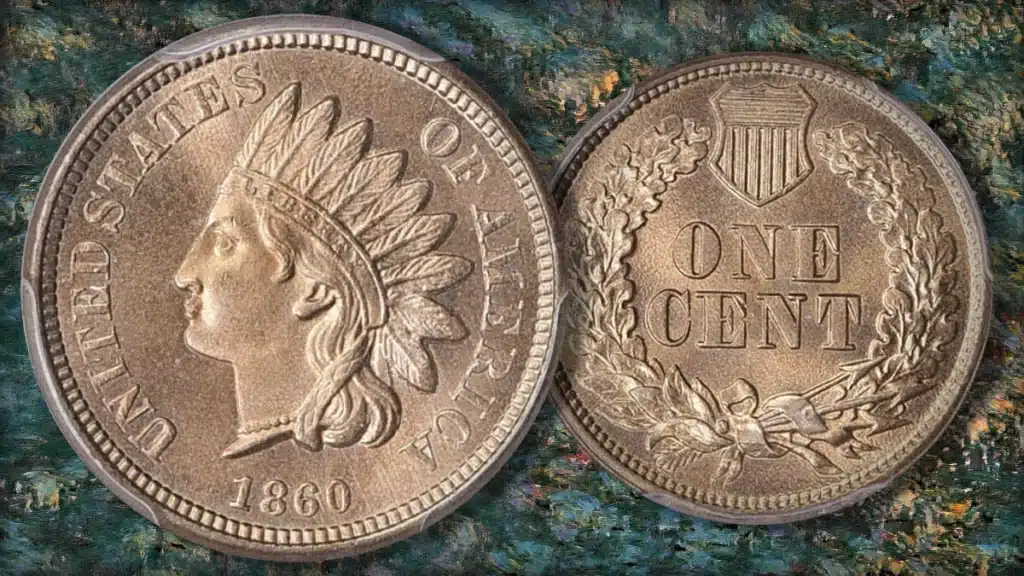
Learn more about the Indian Head cent by reading our collector’s guide on the copper-nickel issues of 1860-64.
Design
Obverse:
The obverse of the coin shows the legend UNITED STATES OF AMERICA and an Indian head facing to the left, wearing a feather bonnet. The word LIBERTY is shown on the band across the bonnet, and shows the production date below.
Reverse:
The coin’s reverse side shows the denomination, written out as ONE CENT, within a laurel wreath. In 1860, the reverse design was changed slightly, showing ONE CENT within an oak wreath, with three arrows inserted under the ribbon that binds the two branches of the wreath. Above and between the ends of the branches is the shield of the United States. As such, the 1859 Indian Head Cent is a one-year type coin which enjoys continuing popularity among Indian Head Cent collectors and type collector alike.
Edge:
The edge of the 1859 Indian Head cent is plain or smooth, without reeding or lettering.
Coin Specifications
| Indian Head Cent : Laurel Wreath Reverse | |
| Years Of Issue: | 1859 |
| Mintage (Circulation): | 36,400,000 |
| Mintage (Proof): | 800 |
| Alloy: | Copper .880, Nickel .120 |
| Weight: | 4.67 grams |
| Diameter: | 19.00 mm |
| Edge: | Plain |
| OBV Designer | James Barton Longacre |
| REV Designer | James Barton Longacre |
* * *
Additional Resources
Bowers, Q. David. The Experts Guide to Collecting & Investing in Rare Coins. Whitman Publishing.
Breen, Walter. Walter Breen’s Encyclopedia of U.S. Coins. Doubleday.
Guth, Ron and Jeff Garrett. United States Coinage: A Study by Type. Whitman Publishing.
Snow, Richard. A Guide Book of Flying Eagle and Indian Head Cents. Whitman Publishing.
—. The Flying Eagle & Indian Cent Attribution Guide, 3rd Edition. Self published.
Yeoman, R.S and Kenneth Bressett (editor). The Official Red Book: A Guide Book of United States Coins. Whitman Publishing.
* * *
The post 1859 Indian Head Cent : A Collector’s Guide appeared first on CoinWeek: Rare Coin, Currency, and Bullion News for Collectors.
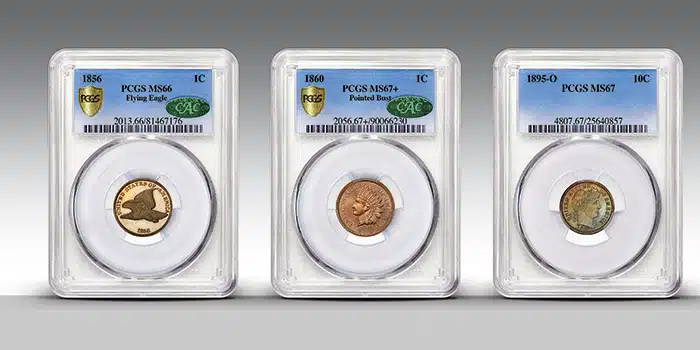

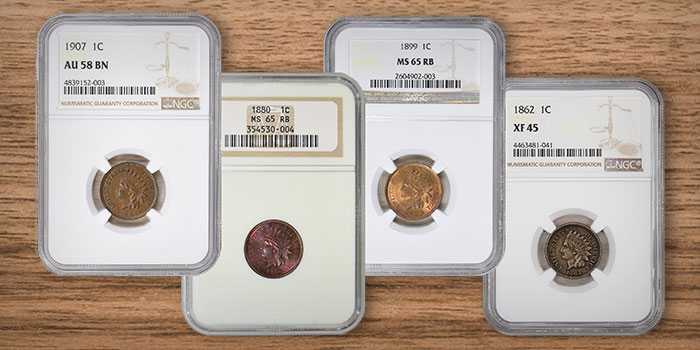


 For Proof coins, prices are modest for lower-grade issues up to near-Gem grades, but as with circulation strikes, for some dates even Premium Gem and finer coins are relatively affordable. The “L On Ribbon” 1864 pieces are expensive in all grades, and very expensive as Gem or finer. A few 1860s issues are more expensive than other dates, and the key date 1877 Proof issue is considerably more expensive than all but the L On Ribbon examples in all grades. Cameo Proof coins have a modest price premium at lower grades that increases at higher grades.
For Proof coins, prices are modest for lower-grade issues up to near-Gem grades, but as with circulation strikes, for some dates even Premium Gem and finer coins are relatively affordable. The “L On Ribbon” 1864 pieces are expensive in all grades, and very expensive as Gem or finer. A few 1860s issues are more expensive than other dates, and the key date 1877 Proof issue is considerably more expensive than all but the L On Ribbon examples in all grades. Cameo Proof coins have a modest price premium at lower grades that increases at higher grades.
